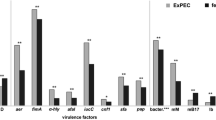Abstract
The current incidence ofEscherichia coli strains in healthy humans capable of producing the inhibitory exoproducts, such as temperate bacteriophages, corpuscular or HMW (high-molar mass) and proteinaceous or LMW (low-molar mass) colicins and siderophores was determined. Fifty-threeE. coli strains were collected from the colons of 53 healthy human volunteers in Brno (Czechia) and tested for spontaneous and induced production of inhibitory exoproducts in a cross-test against each other. Of the strains tested, 37.7% produced bacteriophages, 41.5% produced from one to several LMW colicins, 11.3% formed HMW colicins and 15.1% (eight strains) produced exocellular siderophores different from enterochelin. Of these, seven strains formed aerobactin and one strain formed an untyped siderophore.E. coli strains differ greatly in the incidence of colicinogeny and lysogeny from its closest systemic relatives in the genusEscherichia and therefore should not be regarded as a model bacterium in this respect.
Similar content being viewed by others
References
Bollmann R., Seeburg A., Parschau J., Schonian G., Sokolowska-Kohler W., Halle E., Presber W.: Genotypic and phenotypic determination of five virulence markers in clinical isolates ofEscherichia coli.FEMS Immunol.Med.Microbiol. 17, 263–271 (1997).
Bordet J., Ciuca M.: Evolution des cultures de coli lysogene.Comp.Rend.Soc.Biol. 84, 747–748 (1921).
Braun V., Gross R., Koster W., Zimmermann I.: Plasmid and chromosomal mutants in the iron(III)-aerobactin transport system ofEscherichia coli. Use of streptonigrin for selection.Mol.Gen.Genet. 192, 131–139 (1983).
Bureš J., Horák V., Burešová E., Fixa B., Komárková O.: Colicinogeny in nonspecific intestinal inflammation — I. Colicinogeny in patients with ulcerous colitis, Crohn’s disease and in healthy subjects. (In Czech)Českosl.Gastroenterol.Výž. 37, 81–86 (1983).
Cercenado E., Baquero F., Delgado-Iribarren A., Martinez J.L.: Epidemiology of aerobactin production inEnterobacteriaceae.Ann.Inst.Pasteur Microbiol. 137B, 297–303 (1986).
Fredericq P.: Sur la spécifité des actions antibiotiques.Schweiz.Z.Pathol.Bakteriol. 9, 385–390 (1946).
Gratia A.: Sur un remarquable exemple d’antagonisme entre deux souches de colibacille.Compt.Rend.Soc.Biol. 93, 1040–1041 (1925).
Koczura R., Kaznowski A.: TheYersinia high-pathogenicity island and iron-uptake systems in clinical isolates ofEscherichia coli.J.Med.Microbiol. 52, 637–642 (2003).
Lorkiewicz Z., Maciazek K., Nackiewicz Z.: The influence of acriflavine on transfer of the colicinogenic factors.Acta Microbiol. Polon. 13, 273–281 (1964).
Mennigmann H.D.: Electron microscopy of the antibacterial agent produced byEscherichia coli 15.J.Gen.Microbiol. 41, 151–154 (1965).
Podschun R., Fischer A, Ullmann U.: Characterization ofKlebsiella terrigena strains from humans: hemagglutinins, serum resistance, siderophore synthesis, and serotypes.Epidemiol.Infect. 125, 71–78 (2000).
Šmajs D., Karpathy S.E., Šmarda J., Weinstock G.M.: Colicins produced by theEscherichia fergusonii strains closely resemble colicins encoded byEscherichia coli.FEMS Microbiol.Lett. 208, 259–262 (2002).
Šmarda J.: Incidence and manifestations of colicinogeny in strains ofEscherichia coli.J.Hyg.Epidemol.Microbiol.Immunol. 4, 151–165 (1960).
Šmarda J., Obdržálek V.: Incidence of colicinogenic strains among humanEscherichia coli.J.Basic Microbiol. 41, 367–374 (2001).
Šmarda J., Slováčková H.: Ten new temperate bacteriophages ofCitrobacter youngae.Folia Microbiol. 49, 671–678 (2004).
Šmarda J., Šmajs D., Lhotová H.: Three recently acknowledgedEscherichia species strikingly differ in the incidence of bacteriocinogenic and lysogenic strains.J.Basic Microbiol. 42, 429–433 (2002).
Sonnenborn U., Greinwald R.:Beztehungen zwischen Wirtorganismus und Darmflora. Schattauer, Stuttgart-New York 1991.
Vančíková Z., Lodingová-Žádníková R., Radl J., Tlaskalová-Hogenová H.: The early postnatal development of salivary antibody and immunoglobulin response in children orally colonized with a nonpathogenic, probiotic strain ofE. coli.Folia Microbiol. 48, 281–288 (2003).
Yamamoto S., Tsukamoto T., Terai A., Kurazono H., Takeda Y., Yoshida O.: Distribution of virulence factors inEscherichia coli isolated from urine of cystitis patients.Microbiol.Immunol. 39, 401–404 (1995).
Author information
Authors and Affiliations
Corresponding author
Additional information
This work was supported by grants from theGrant Agency of the Czech Republic (310/01/0013 and 310/03/1091) and by the institutional support of theMinistry of Education, Youth and Sports of the Czech Republic (MŠM 002 162 2415).
Rights and permissions
About this article
Cite this article
Šmarda, J., Šmajs, D. & Horynová, S. Incidence of lysogenic, colicinogenic and siderophore-producing strains among human non-pathogenicEscherichia coli . Folia Microbiol 51, 387–391 (2006). https://doi.org/10.1007/BF02931581
Received:
Revised:
Issue Date:
DOI: https://doi.org/10.1007/BF02931581




